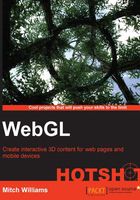
Lights, camera, action!
"Lights, camera, action!" is an old Hollywood phrase to start filming, but it is just as applicable to interactive 3D graphics. So, let's add lights, cameras, and interactivity to our X3D scenes.

Engage thrusters
This scene retains the first two objects created previously and adds a point light that can be thought of as a light bulb—a light from a single point emanating in all directions. We turned off the headlight inside the <NavigationInfo> tag, and at the same time, restricted movement in the scene by setting type to NONE, simply to introduce this as part of the demo. At the same time, the <Viewpoint> tag or camera is introduced with its default position value, orientation (rotation) value, and fieldOfView value that defaults to π/4, that is, 0.785 radians. The added code is as follows:
<Scene>
<NavigationInfo headlight="FALSE" type='"NONE"'/>
<PointLight location="0 3 2"/>
<Viewpoint position="0 0 10" orientation="0 0 1 0"
fieldOfView=".785"/>
<Transform …>
The point light is 3 units up and 2 units in front, so it clearly shines on the top of the box and to the left-hand side of the cone but not on the left-hand side of the box or the bottom of the cylinder.